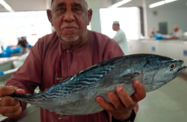The Omani government is taking steps to ensure greater food security, identifying self-sufficiency in production and cost stabilisation as its major goals. With food costs on the rise throughout the region, officials hope new strategies will curb price volatility and assuage public concern over rising living expenses.
According to a consumer price index report released by the Ministry of National Economy in January, the prices of foods fluctuated somewhat in year-on-year (y-o-y) terms. Food, beverages and tobacco products in 2010 registered an average price increase of only 2% y-o-y. Over the course of the decade, however, costs have jumped significantly – up 154.4% since 2000. The same situation has occurred across a range of other products. Vegetable prices increased 12.1% y-o-y in 2010, but saw a 168.9% rise over the course of the decade. Fish and seafood products were 9.3% more expensive in 2010 over 2009 and rose 182.5% over the decade. Other categories fared the same: sugar and sugar goods (8.2%, 155.1%); spices and salt (6.9%, 149%); non-alcoholic beverages (2.9%, 112%); and nuts (2.9%, 127.4%); while meat and poultry (1.6%, 174%) and fruits (1.4%, 124%) saw smaller y-o-y increases, according to the Ministry of National Economy’s report. Omani families spend up to 28% of their income on food, compared to a global average of 12%.
Members of the agricultural and food production community – including wholesalers, retailers, agricultural association representatives and scholars – met to discuss ideas for improving food security and cutting consumer costs at a roundtable event sponsored by the Oman Chamber of Commerce & Industry (OCCI) on February 6. These strategies included the construction of 52 warehouses across the country for the purpose of storing grain and other commodities, thereby ensuring that even remote rural areas have access to food reserves. According to Khalil Abdullah Al Khonji, chairman of the OCCI, the warehouses will be built at an estimated cost of OR42m ($109.5m). Additionally, plans are in place to construct several silos for the storage of wheat flour reserves, including a facility with a 200,000-tonne capacity at Sohar Port. The government will also focus on increasing public awareness on the importance of improving eating habits and consuming domestically produced fruits and vegetables.
“There is an urgent need to bring under cultivation high-yielding varieties of crops suitable for different regions of Oman,” Abdus Sattar Basra, manager of the National Company for Agriculture and Livestock Development, told The Oman Daily Observer. Bastra stressed the need to cut production costs by reducing other expenses, including rent, labour, electricity and fertiliser. Only by bringing down costs for farmers will the government be able to close the gap between farm prices and retail prices, he said.
Participants in the roundtable event also discussed speeding up development in the north-eastern Al Batinah region, with plans in place to increase wheat cultivation and to establish wholesale markets for vegetables and livestock in the coastal town of Barka.
The discussion gave particular attention to the local fish market. The high level of exports in the segment often leads to domestic shortages. A proposal to ban exports of four kinds of fish during certain months was unveiled at the roundtable, according to a February 7 report in the local press.
“That needs approval from the cabinet council,” Al Khonji told the Times of Oman. “Once it is implemented, we hope the availability of fish will improve in the domestic market.”
Government officials are also developing wholesale fish markets with the aim of making more of the fish catch available for local consumption.
"The wholesale vegetable and livestock markets are in line with the wholesale fish market coming up in Barka,” Al Khonji told the Times of Oman. “We think that with the increase in availability, prices will come down.”
The upward trend in global food prices led World Bank President Richard Zoellick to emphasise the importance of curbing price volatility in an interview with Reuters on February 2. He said higher prices were pushing the Food Price Index of the UN Food and Agriculture Organisation to record highs.

